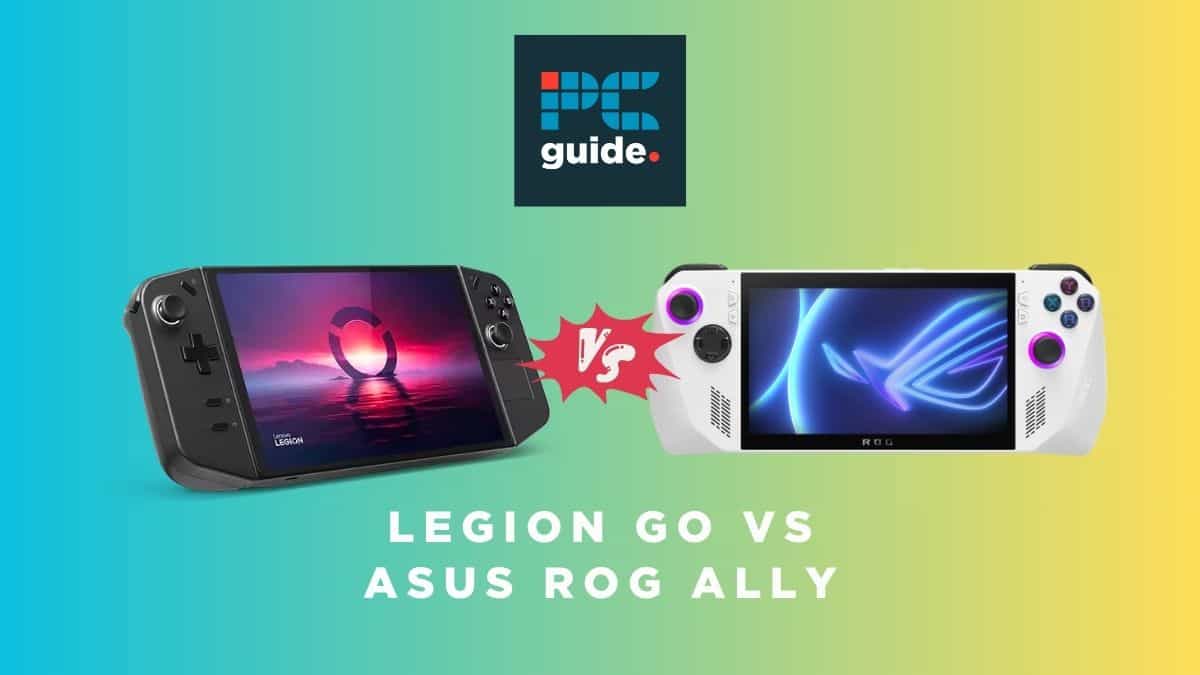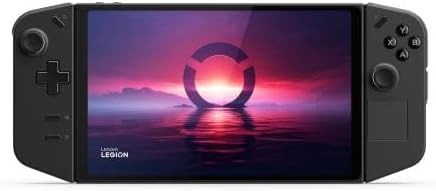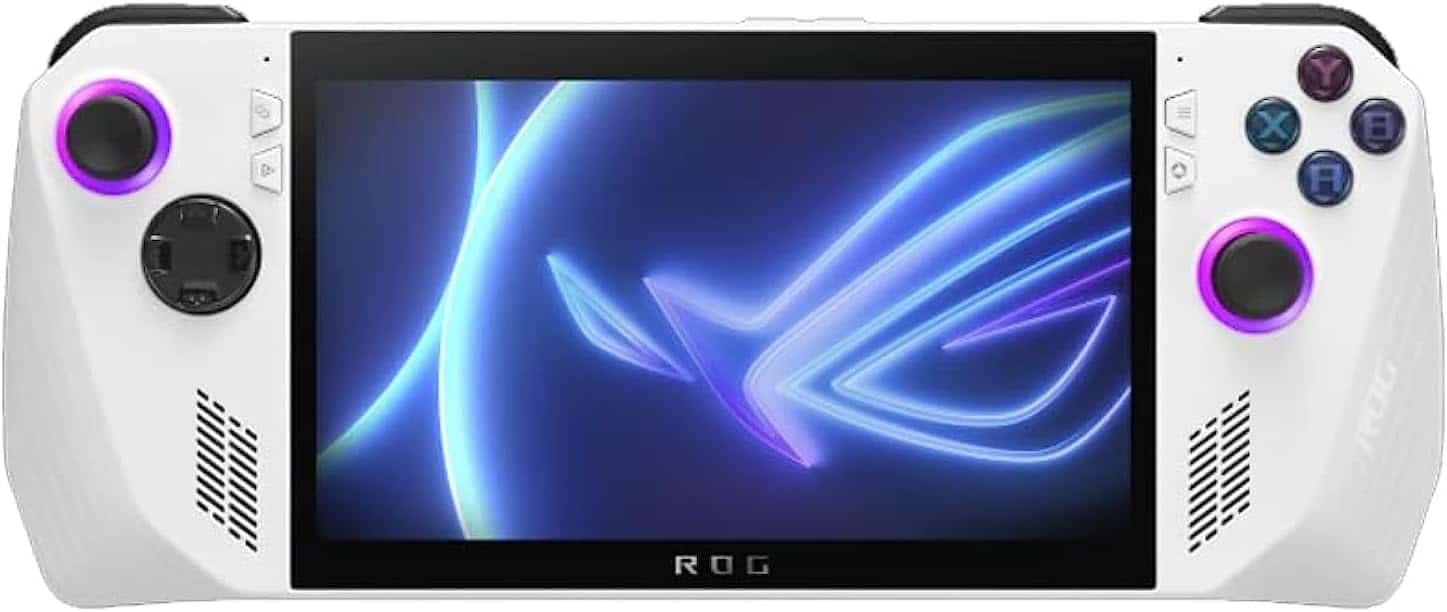Legion Go vs Asus ROG Ally – portable PC rivals

Table of Contents
In the upcoming genre of portable gaming PCs, there are two front-runners from Lenovo and Asus – we’re putting them head-to-head in the Legion Go vs Asus ROG Ally. Handheld consoles have seen somewhat of a resurgence this year, with even more powerful hardware and graphics coming to the devices. Gaming enthusiasts are now on the lookout for the latest and greatest handheld gaming PC, and with the emergence of the Lenovo Legion Go and Asus ROG Ally, the competition has become even more intense. In this article, we’re comparing these two devices to help you determine which one is better suited to your gaming needs.
Legion Go vs Asus ROG Ally specs
| Specifications | Lenovo Legion Go | Asus ROG Ally |
|---|---|---|
| Release date | Nov. 1, 2023 | Jun. 13, 2023 |
| Price | $699 | $599 |
| Display | 8.8-inch IPS, 16:10 aspect ratio, Quad HD+ (2560×1600), 144Hz refresh rate, 97% DCI-P3, 500 nits, touch | 7-inch IPS, 1920×1080, 120Hz refresh rate, touch |
| Chipset | Up to AMD Ryzen Z1 Extreme (8 cores, 16 threads, up to 5.1GHz, 16MB L3 cache) | Up to AMD Ryzen Z1 Extreme (8 cores, 16 threads) |
| Operating system | Windows 11 | Windows 11 |
| Ports | 2x USB4 (one on top, one at the bottom) 3.5mm headphone jack microSD card reader | 1x USB-C, 1x ROG Xg Mobile interface, 3.5mm headphone jack |
Legion Go vs Asus ROG Ally features
Now, that we’ve seen the specs, let's check out the features of both devices.
Prime Day may have closed its doors, but that hasn't stopped great deals from landing on the web's biggest online retailer. Here are all the best last chance savings from this year's Prime event.
- Sapphire Pulse AMD Radeon™ RX 9070 XT Was $779 Now $719
- AMD Ryzen 7 7800X3D Processor Was $449 Now $341
- Skytech King 95 Ryzen 7 9800X3D gaming PC Was $2,899 Now $2,599
- LG 77-Inch Class OLED C5 TV Was $3,696 Now $2,996
- AOC Laptop Computer 16GB RAM 512GB SSD Was $360.99 Now $306.84
- Lexar 2TB NM1090 w/HeatSink SSD Was $281.97 Now $214.98
- Apple Watch Series 10 GPS+ Smartwatch Was $499.99 Now $379.99
- AMD Ryzen 9 5950X processor Was $3199.99 Now $279.99
- Garmin vívoactive 5 Smartwatch Was $299.99 Now $190
*Prices and savings subject to change. Click through to get the current prices.
Display
When it comes to display, the Legion Go boasts an 8.8-inch IPS touch display with a 16:10 aspect ratio and a Quad HD+ resolution of 2560×1600, making it one of the biggest handhelds out there. It also has a 144Hz refresh rate, offering smooth and immersive visuals. In contrast, the ROG Ally features a smaller 7-inch IPS touch display with a Full HD resolution of 1920×1080 and a 120Hz refresh rate. While the Legion Go might offer a larger and higher-resolution screen, the ROG Ally’s display seems to be optimized for better performance and manageability.
Design
In terms of design, the Lenovo Legion Go and Asus ROG Ally have distinct differences. The Legion Go features detachable controllers, allowing for greater versatility in gaming. The controllers can be released with the press of a button and the device also includes a kickstand on the rear, similar to the Nintendo Switch. However, this does mean that the Legion Go is bulkier in comparison, measuring 11.8 inches in length and weighing about 1.88 pounds with the controllers attached. Without the controllers, it measures 8.27 inches in length and weighs 1.41 pounds.
On the other hand, the Asus ROG Ally is more compact and does not have the detachable controllers feature. It measures 11.02 inches in length and weighs about 1.34 pounds. The ROG Ally is designed as a single unit with built-in controllers, providing a more streamlined and portable gaming experience.
Controllers
The controllers of the Lenovo Legion Go and Asus ROG Ally also differ in functionality. The Legion Go’s detachable controllers resemble those of the Nintendo Switch, although they cannot be joined together when detached. The right controller of the Legion Go features an optical sensor on the underside, handily allowing it to be used in FPS mode. It also includes a touchpad on the side and a mouse wheel on the back, making navigation in its Windows 11 OS easier. The thumbstick on the controller utilizes Hall sensors to prevent stick drift, and it can be customized with RGB lighting.
In comparison, the Asus ROG Ally’s controllers are non-detachable and do not offer the same level of versatility as the Legion Go. However, they still feature the Xbox-style ABXY layout and a dedicated D-pad, which are commonly preferred for PC gaming. The ROG Ally’s controllers do not include a touchpad, so navigation options are limited to the thumbstick and touchscreen.
Operating system
Both the Lenovo Legion Go and Asus ROG Ally run on Windows 11, providing access to a wide range of PC gaming platforms such as Steam, Xbox Game Pass, and the Epic Games Store. While Windows 11 offers compatibility with various PC games, it is important to note that the operating system is not yet fully optimized for touchscreens, which may affect the overall user experience. With the popularity of portable gaming PCs on the rise, it’s likely we’ll see this all smoothed out at points in the future.
Legion Go vs Asus ROG Ally price
The Asus ROG Ally is currently available for purchase, with a starting price of $599. This particular model comes with the AMD Ryzen Z1 Extreme chip and 512GB of SSD storage. Asus has also announced a lower-end model with the regular Ryzen Z1 and 256GB of storage. On the other hand, the Lenovo Legion Go has a starting price of $699. It’s a $100 more expensive investment, but it gets you a bigger display, the versatility of detachable controllers, and a more powerful processor in the base level. Needless to say, you get what you pay for.
Is the Legion Go better than the ASUS ROG Ally?
If you prioritize versatility and a larger display, the Lenovo Legion Go may be the better choice for you. However, if portability and performance are your main concerns, the Asus ROG Ally comes out as a solid option. Additionally, the latter has a bigger expanse of settings options within its Armoury Crate software, and its VRR support helps games run a bit more smoothly than you perhaps might get on the Legion Go. Whichever device you choose, both the Legion Go and ROG Ally offer exciting gaming experiences on the go, and are industry trendsetters when it comes to the creation of powerful and stylish portable gaming PCs.
What controllers are compatible with the ROG Ally?
The ROG Ally is a handheld device, but like most versatile handhelds you can stream your console from a bigger display. Naturally, this means you will also need to make use of an external controller. Luckily, the magic of Bluetooth means that most modern controllers will be able to connect to your ROG Ally. There’s also a USB-C port for a wires controller connection too. The Xbox controller has the same ABXY layout as the ROG Ally, so perhaps this will be the preferred choice of some.



